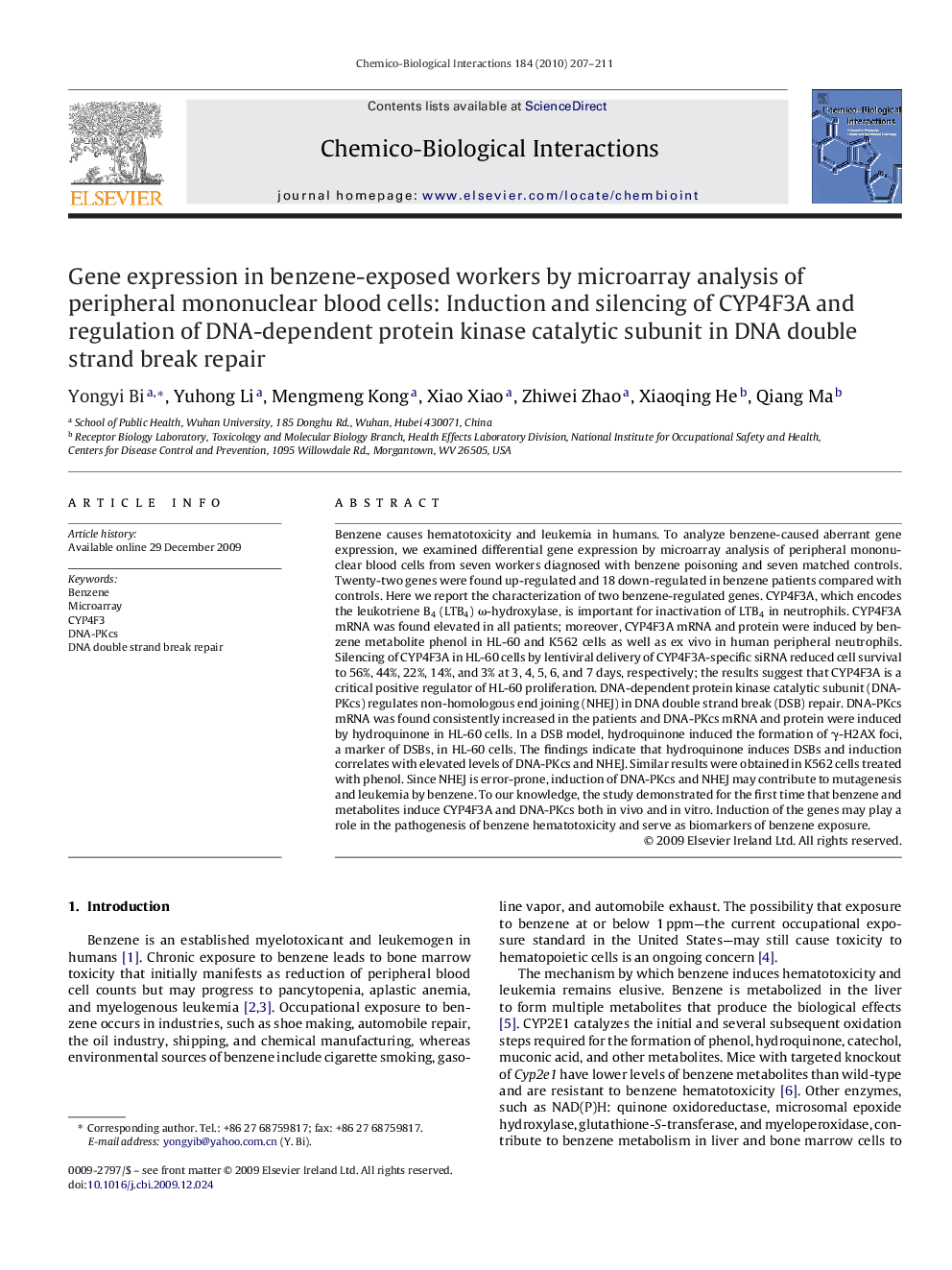| کد مقاله | کد نشریه | سال انتشار | مقاله انگلیسی | نسخه تمام متن |
|---|---|---|---|---|
| 2581150 | 1561647 | 2010 | 5 صفحه PDF | دانلود رایگان |
عنوان انگلیسی مقاله ISI
Gene expression in benzene-exposed workers by microarray analysis of peripheral mononuclear blood cells: Induction and silencing of CYP4F3A and regulation of DNA-dependent protein kinase catalytic subunit in DNA double strand break repair
دانلود مقاله + سفارش ترجمه
دانلود مقاله ISI انگلیسی
رایگان برای ایرانیان
کلمات کلیدی
موضوعات مرتبط
علوم زیستی و بیوفناوری
علوم محیط زیست
بهداشت، سم شناسی و جهش زایی
پیش نمایش صفحه اول مقاله

چکیده انگلیسی
Benzene causes hematotoxicity and leukemia in humans. To analyze benzene-caused aberrant gene expression, we examined differential gene expression by microarray analysis of peripheral mononuclear blood cells from seven workers diagnosed with benzene poisoning and seven matched controls. Twenty-two genes were found up-regulated and 18 down-regulated in benzene patients compared with controls. Here we report the characterization of two benzene-regulated genes. CYP4F3A, which encodes the leukotriene B4 (LTB4) Ï-hydroxylase, is important for inactivation of LTB4 in neutrophils. CYP4F3A mRNA was found elevated in all patients; moreover, CYP4F3A mRNA and protein were induced by benzene metabolite phenol in HL-60 and K562 cells as well as ex vivo in human peripheral neutrophils. Silencing of CYP4F3A in HL-60 cells by lentiviral delivery of CYP4F3A-specific siRNA reduced cell survival to 56%, 44%, 22%, 14%, and 3% at 3, 4, 5, 6, and 7 days, respectively; the results suggest that CYP4F3A is a critical positive regulator of HL-60 proliferation. DNA-dependent protein kinase catalytic subunit (DNA-PKcs) regulates non-homologous end joining (NHEJ) in DNA double strand break (DSB) repair. DNA-PKcs mRNA was found consistently increased in the patients and DNA-PKcs mRNA and protein were induced by hydroquinone in HL-60 cells. In a DSB model, hydroquinone induced the formation of γ-H2AX foci, a marker of DSBs, in HL-60 cells. The findings indicate that hydroquinone induces DSBs and induction correlates with elevated levels of DNA-PKcs and NHEJ. Similar results were obtained in K562 cells treated with phenol. Since NHEJ is error-prone, induction of DNA-PKcs and NHEJ may contribute to mutagenesis and leukemia by benzene. To our knowledge, the study demonstrated for the first time that benzene and metabolites induce CYP4F3A and DNA-PKcs both in vivo and in vitro. Induction of the genes may play a role in the pathogenesis of benzene hematotoxicity and serve as biomarkers of benzene exposure.
ناشر
Database: Elsevier - ScienceDirect (ساینس دایرکت)
Journal: Chemico-Biological Interactions - Volume 184, Issues 1â2, 19 March 2010, Pages 207-211
Journal: Chemico-Biological Interactions - Volume 184, Issues 1â2, 19 March 2010, Pages 207-211
نویسندگان
Yongyi Bi, Yuhong Li, Mengmeng Kong, Xiao Xiao, Zhiwei Zhao, Xiaoqing He, Qiang Ma,